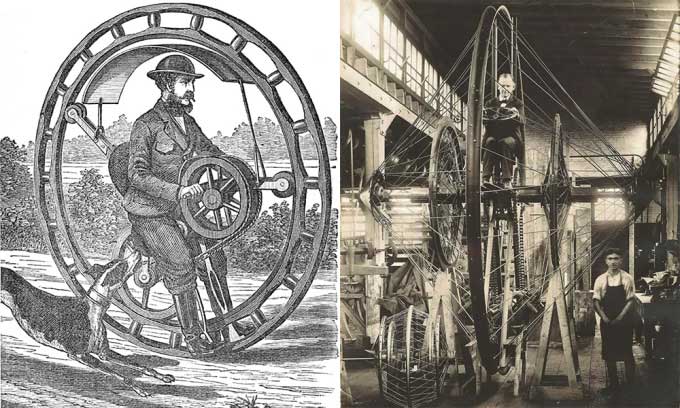The period from 1860 to 1930 saw the monowheel, a one-wheeled vehicle, frequently mentioned as a new mode of transportation, despite facing numerous design issues.
In 1869, French inventor Richard C. Hemmings patented the first monowheel, resembling a giant wheel with a seat inside. However, the vehicle actually had two wheels: a smaller one beneath the seat. The rider pedaled to move the smaller wheel, causing the larger wheel to roll as well. At that time, the monowheel was noted to be a difficult and impractical means of transportation for the average person.

Richard C. Hemmings’ monowheel (left) and Professor E. J. Christie’s 4.3-meter “monster” monowheel from 1923. (Photo: Rare Historical Photos).
By the early 20th century, inventors began experimenting with motorized monowheel designs. Some even fabricated vehicles with airplane propellers mounted at the front to assist in movement. However, none of these designs went into mass production.
In the 1930s, science magazines started to showcase monowheel designs resembling automobiles, featuring metal frames that could carry several passengers.
The most famous design of this bizarre vehicle type may be the one created by Dr. J. A. Purves in 1932. This motorized vehicle was named Dynasphere, capable of reaching speeds of 25 to 30 km/h. Purves believed that the monowheel was the simplest motorized vehicle possible. However, the Dynasphere never achieved the success he anticipated. It was not a stable vehicle, could only carry one passenger along with the driver, and faced numerous insurmountable design issues.
The Dynasphere monowheel. (Video: British Pathé)
The monowheel differs from the unicycle in that the rider sits inside the wheel, rather than on top or outside of it, functioning like a giant ball bearing. The rider and engine are anchored within the inner wheel, while the engine propels the outer wheel forward.
Monowheels can remain upright due to principles similar to those of a gyroscope. As long as there is an external force creating motion, in this case, an engine (although some vehicles are pedal-powered), the vehicle will operate.
Steering the monowheel is quite difficult due to the lack of supporting wheels, and its somewhat eccentric design complicates handling. Riders often prefer to keep their feet close to the ground to prevent tipping over.
Furthermore, if the vehicle is equipped with a powerful engine, it is challenging to utilize the engine’s full potential given this design. The instability when not moving forward makes braking exceedingly difficult.
Overall, there are many inherent design problems that inventors need to address, such as obstructed visibility, instability, difficulty in maneuvering, and the phenomenon of “mouse jumping.” This phenomenon can occur when the rider accelerates or brakes too quickly, causing the forces acting on them to exceed the gravitational pull keeping them at the bottom of the wheel. As a result, the rider risks spinning inside the wheel like a pet mouse when it abruptly stops running while the wheel continues to spin.
Ultimately, monowheels have never gained popularity. Today, they are still manufactured and tested, but typically only for recreational purposes.





















































